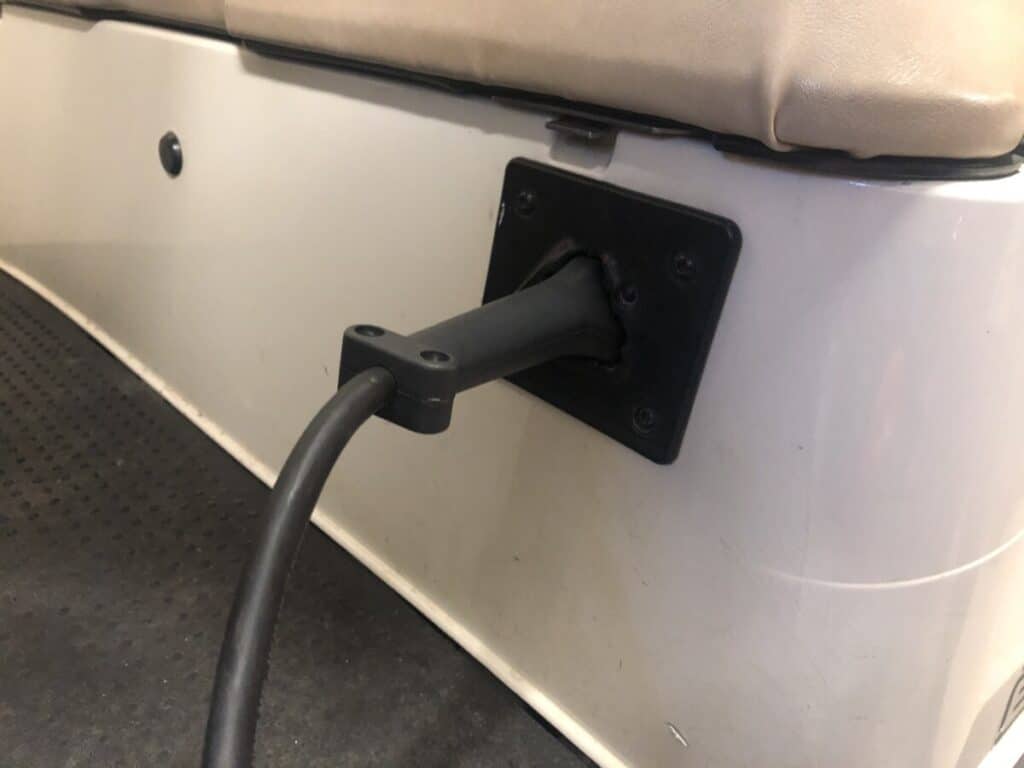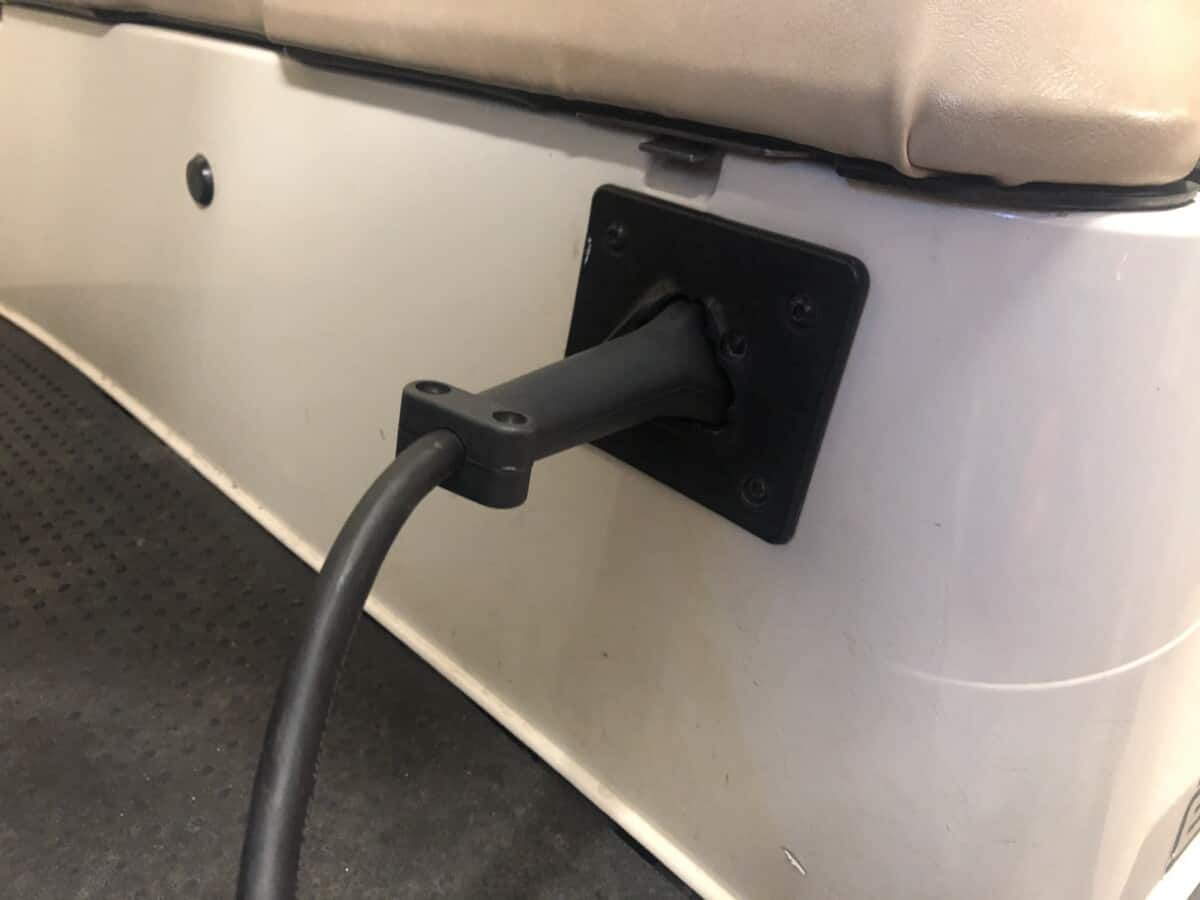
“Should I leave my golf cart plugged in all the time while I am not using it,” is one of the most asked questions surrounding electric golf carts. Obviously, a large percentage of the owners who are asking this question have recently purchased their first golf cart, but there are also quite a few long-term golf cart owners that ask this question. The main reason would be a concern for the golf cart battery.
Manufacturers recommend leaving your golf cart plugged in all of the time, but only if using an automatic battery charger. This will keep the batteries topped off and ready to go. If batteries are not charged over a storage period of several months, they can deteriorate and provide less capacity.
When there are experienced and inexperienced owners asking the same question, you have to wonder if this question is being addressed by golf cart manufacturers and where the confusion surrounding the questions is sprouting from. Below, we will dive deep into the origins of this confusion, explore the various charging procedures for electric golf carts, and once and for all answer the questions everyone is asking. Whether you are a novice golf cart owner who just purchased their first electric cart, or a long-term owner who is still not sure how they should properly charge their vehicle, you should continue reading below!
The Confusion Surround Electric Golf Cart Charging
The three major manufacturers of electric golf carts are Club Car, E-Z-GO, and Yamaha, and it seems most of the confusion surrounding the question at hand is their fault. Well, let’s not blame any of the three companies, but they are certainly responsible, for each of these three major golf cart manufacturers address the question differently. Another factor could be if you have an aftermarket golf cart battery charger.
Therefore, the proper charging procedure described in the user manual for a Club Car cart is different from the proper charging procedure that is described in the user manual for an E-Z-GO cart. As these proper procedures floated around the golf cart world and golf cart owners interacted with one another, this confusion must have started to build. You can imagine a scenario where one friend tells another that their charging procedure is wrong, when in reality they are both following the exact guidelines laid out in their user manuals.
To actually get to the bottom of this confusion and find out what the proper charging procedure is for your golf cart, you will need to figure out what procedure your manufacturer recommends. Next, we will take a look at the various guidelines given out by Club Car, E-Z-GO, and Yamaha.
The voltage of your electric golf cart battery is not really a factor when determining out how to charge, the type of batteries and charger are the items to pay attention to.
Lead Acid Battery General Charging Recommendations
Lead acid batteries do not like to be topped off all time time. It is important when you run them, to run them down at least 25% or more. If you are running to get your mail for 5 minutes every day and throw the charger plug in, you will be doing more harm than running them down a bit more to get more battery discharge before they are recharged.
Club Car Charging Recommendations
In general, Club Car has manufactured golf carts with two different types of batteries over the last several years. They have produced carts with 48V lead-acid configurations and lithium ion batteries. However, the 48V lead acid carts are the most common. The Club Car guidelines for charging such a cart are as follows:
- The battery chargers should be left plugged in during prolonged storage
- The OBC will automatically activate the charge if necessary
- If you leave the battery chargers plugged in for an extended amount of time, the electrolytes in the battery pack should be checked monthly and distilled water should be added.
- AC power should also be checked monthly in extended storage situations
Therefore, according to Club Car if you are storing your golf cart you should leave it plugged in consistently. However, you should also be aware of its electrolyte levels and check these levels and the AC power periodically to make sure your storage unit power didn’t get shut off and your batteries are depleting.
It is important to have a good-quality automatic golf cart charger that will adequately charge your batteries. We have this model and believe it to be one of the best on the market.
E-Z-GO Charging Recommendations
Compared to Club Car, E-Z-GO, has produced a wider assortment of vehicles in recent years. The manufacturer has produced carts with 36V configurations, 48V configurations, 72V configurations, and a few that capitalize on lithium-ion technology. To keep things succinct and eliminate creating any further confusion, we will look at the guidelines E-Z-GO provides for a cart equipped with a 48V lead acid configuration. The E-Z-GO charging guidelines for such a cart are as follows:
- The battery chargers can be left plugged in during prolonged storage, if the charger is plugged into an active electrical source
- If the electrical source is not consistent, you should not leave the battery chargers plugged in, for the battery charger will automatically continue to address the battery pack. This continued effort will lead the batteries to be completely drained if power to the electrical source is not restored.
Therefore, according to E-Z-GO, you can leave your golf cart plugged in during prolonged storage, but you should do so hesitant and at your own risk. The manufacturer points out that problems with your electrical source could cause problems to your cart’s batteries. As with lead acid batteries, proper golf cart battery maintenance is key. Always check voltage and electrolyte levels when in prolonged storage.
We throw our RXV on this charger and are able to leave it plugged in and it will automatically top off the batteries if need be.
If you have a TXT 48 Volt, this is the model you would get, or if you have a 36V, this one will do.
Yamaha Charging Recommendations
Unlike Club Car’s and E-Z-GO’s confusing but moderately invasive charging instructions, Yamaha’s instructions are direct and somewhat troublesome. Like the other two manufacturers, Yamaha has produced several different golf carts over the years, but their charging instructions are roughly the same from cart to cart. However, just to be as synchronized as possible we will look at the charging instructions for a 48V lead acid configuration. The Yamaha charging guidelines for such a cart are as follows:
- During prolonged storage, owners should remove the batteries from their cart and keep them in a cool, dry place.
- The location of storage should maintain a temperature between 0 degrees celsius (32F) and 32 degrees Celsius (90F).
- Charge the batteries every 60 to 90 days to make sure they maintain their charge and avoid damage.
Therefore, according to Yamaha, owners should remove their batteries and store them separately from their golf carts when entering prolonged storage. Also, owners should reinstall their batteries back into the cart every 60 to 90 days to charge the batteries and prevent damage from occurring. While this procedure seems intense, it is exactly what Yamaha recommends.
As we know, it is a pain to uninstall and reinstall golf cart batteries, my recommendation would be to make sure your golf cart is stored above 32 degrees F and keep them charged and maintained throughout winter. This will prolong their life and keep older batteries running for a long time.
A good automatic charger for your Yamaha will keep your batteries topped off. Our favorite model is offered for the G29/Drive, and the G19/G22 here.
Summary: Should I Leave My Golf Cart Charging All the Time
In conclusion, the answer to the question at hand is most likely: No, you shouldn’t always leave your cart plugged in when you are not using it. However, depending upon which type of golf cart you have, the proper guidelines from your manufacturer will differ. According to Club Car, you should leave your cart plugged in during storage and let the computer detect when the batteries need a charge. According to E-Z-GO, you can leave your cart charging during storage, but you should consistently check on your power source. And, according to Yamaha, you should remove your batteries from the cart completely.

